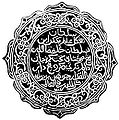Spread of Islam
This article includes a list of general references, but it lacks sufficient corresponding inline citations. (March 2023) |
| Part of a series on |
| Islam |
|---|
 |
| Part of a series on |
Islamization |
|---|
 |
The spread of Islam spans almost 1,400 years. The
As of 2016, there were 1.7 billion Muslims,[9][10] with one out of four people in the world being Muslim,[11] making Islam the second-largest religion.[12] Out of children born from 2010 to 2015, 31% were born to Muslims[13] and currently Islam is the world's fastest-growing major religion by births while Pentecostalism is the fastest growing by converts.[14][15][16]
Terminology
Alongside the terminology of the "spread of Islam", scholarship of the subject has also given rise to the terms "Islamization",
The English synonym of "Muslimization", in use since before 1940 (e.g., Waverly Illustrated Dictionary), conveys a similar meaning as "Islamization". 'Muslimization' has more recently also been used as a term coined to describe the overtly Muslim practices of new converts to the religion who wish to reinforce their newly acquired religious identity.[20]
History
| Part of a series on |
| History of religions |
|---|
Muslim Arab expansion in the first centuries after
Rashidun Caliphs and Umayyads (610–750 CE)
Within the century of the establishment of Islam upon the Arabian Peninsula and the subsequent rapid expansion during the early Muslim conquests, one of the most significant empires in world history was formed.[22] For the subjects of the empire, formerly of the Byzantine and the Sasanian Empires, not much changed in practice. The objective of the conquests was mostly of a practical nature, as fertile land and water were scarce in the Arabian Peninsula. A real Islamization therefore came about only during the subsequent centuries.[23]
Ira M. Lapidus distinguishes between two separate strands of converts of the time: animists and polytheists of tribal societies of the Arabian Peninsula and the Fertile Crescent and the native Christians and Jews existing before the Muslims arrived.[24]
The empire spread from the Atlantic Ocean to the Aral Sea, from the Atlas Mountains to the Hindu Kush. It was bounded mostly by "a combination of natural barriers and well-organized states".[25]
For the polytheistic and pagan societies, apart from the religious and spiritual reasons that individuals may have had, conversion to Islam "represented the response of a tribal, pastoral population to the need for a larger framework for political and economic integration, a more stable state, and a more imaginative and encompassing moral vision to cope with the problems of a tumultuous society."[24] In contrast, for tribal, nomadic, monotheistic societies, "Islam was substituted for a Byzantine or Sassanian political identity and for a Christian, Jewish or Zoroastrian religious affiliation."[24] Conversion initially was neither required nor necessarily wished for: "(The Arab conquerors) did not require the conversion as much as the subordination of non-Muslim peoples. At the outset, they were hostile to conversions because new Muslims diluted the economic and status advantages of the Arabs."[24]
Only in subsequent centuries, with the development of the religious doctrine of Islam and with that the understanding of the Muslim ummah, would mass conversion take place. The new understanding by the religious and political leadership in many cases led to a weakening or breakdown of the social and religious structures of parallel religious communities such as Christians and Jews.[24]
The caliphs of the Arab dynasty established the empire's first school, which taught the Arabic language and Islamic studies. The caliphs furthermore began the ambitious project of building mosques across the empire, many of which remain today, such as the Umayyad Mosque, in Damascus. At the end of the Umayyad period, less than 10% of the people in Iran, Iraq, Syria, Egypt, Tunisia and Spain were Muslim. Only the Arabian Peninsula had a higher proportion of Muslims among the population.[26]
Abbasids (750–1258)
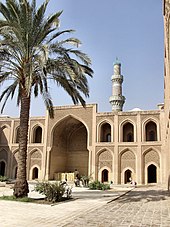
The Abbasids replaced the expanding empire and "tribal politics" of "the tight-knit Arabian elite
"Islam had become more clearly defined, and the line between Muslims and non-Muslims more sharply drawn. Muslims now lived within an elaborated system of ritual, doctrine and law clearly different from those of non-Muslims. (...) The status of Christians, Jews and Zoroastrians was more precisely defined, and in some ways it was inferior. They were regarded as the 'People of the Book', those who possessed a revealed scripture, or 'People of the Covenant', with whom compacts of protection had been made. In general, they were not forced to convert, but they suffered from restrictions. They paid a special tax; they were not supposed to wear certain colors; they could not marry Muslim women;."[26]
Most of those laws were elaborations of basic laws concerning non-Muslims (dhimmis) in the Quran, which does not give much detail about the right conduct with non-Muslims, but it in principle recognises the religion of "People of the Book" (Jews, Christians and sometimes others as well) and securing a separate tax from them that replaces the zakat, which is imposed upon Muslim subjects.
Ira Lapidus points towards "interwoven terms of political and economic benefits and of a sophisticated culture and religion" as appealing to the masses.[27] He noted:
"The question of why people convert to Islam has always generated the intense feeling. Earlier generations of European scholars believed that conversions to Islam were made at the point of the sword, and that conquered peoples were given the choice of conversion or death. It is now apparent that conversion by force, while not unknown in Muslim countries, was, in fact, rare. Muslim conquerors ordinarily wished to dominate rather than convert, and most conversions to Islam were voluntary. (...) In most cases, worldly and spiritual motives for conversion blended together. Moreover, conversion to Islam did not necessarily imply a complete turning from an old to a totally new life. While it entailed the acceptance of new religious beliefs and membership in a new religious community, most converts retained a deep attachment to the cultures and communities from which they came."[27]
The result, he points out, can be seen in the diversity of Muslim societies today, with varying manifestations and practices of Islam.
Conversion to Islam also came about as a result of the breakdown of historically-religiously organized societies: with the weakening of many churches, for example, and the favouring of Islam and the migration of substantial Muslim Turkish populations into the areas of Anatolia and the Balkans, the "social and cultural relevance of Islam" were enhanced and a large number of peoples were converted. This worked better in some areas (Anatolia) and less in others (such as the Balkans in which "the spread of Islam was limited by the vitality of the Christian churches".)[24]
Along with the religion of Islam, the Arabic language, Arabic numerals and Arab customs spread throughout the empire. A sense of unity grew among many though not all provinces and gradually formed the consciousness of a broadly Arab-Islamic population. What was recognizably an Islamic world had emerged by the end of the 10th century.[28] Throughout the period, as well as in the following centuries, divisions occurred between Persians and Arabs, and Sunnis and Shias, and unrest in provinces empowered local rulers at times.[26]
Conversion within the empire: Umayyad vs. Abbasid period
There are a number of historians who see the rule of the Umayyads as responsible for setting up the "dhimmah" to increase taxes from the
During the following
Conversion within the empire: "Conversion curve"
Growth rate
In addition to conversion to Islam, the Muslim population also grew from a higher birth rate than non-Muslims as a result of the rights of Muslim men to marry four women, have numerous concubines and raise their children as Muslims.[31]
Emergence of the Seljuks and Ottomans (950–1450)
The expansion of Islam continued in the wake of
Ottoman Empire (1299–1924)

The
Later, the Ottoman Empire set on to conquer territories from these rivals: Cyprus and other Greek islands (except Crete) were lost by Venice to the Ottomans, and the latter conquered territory up to the Danube basin as far as Hungary. Crete was conquered during the 17th century, but the Ottomans lost Hungary to the Holy Roman Empire, and other parts of Eastern Europe, which ended with the
The Ottoman sultanate was abolished on 1 November 1922 and the caliphate was abolished on 3 March 1924.[33]
Modern
Islam has continued to spread through commerce and migrations, especially in Southeast Asia, America and Europe.[22]
Modern day Islamization appears to be a return of the individual to Muslim values, communities, and dress codes, and a strengthened community.[34]
Another development is that of transnational Islam, elaborated upon by the French Islam researchers
The increased integration of world societies as a result of enhanced communications, media, travel, and migration makes meaningful the concept of a single Islam practiced everywhere in similar ways, and an Islam which transcends national and ethnic customs.[35]
This does not necessarily imply political or social organizations:
Global Muslim identity does not necessarily or even usually imply organized group action. Even though Muslims recognize a global affiliation, the real heart of Muslim religious life remains outside politics—in local associations for worship, discussion, mutual aid, education, charity, and other communal activities.[35]
A third development is the growth and elaboration of transnational military organizations. The 1980s and 90s, with several major conflicts in the
By region
Arabia
At Mecca, Muhammad is said to have received repeated embassies from Christian tribes.
Greater Syria
Like their Byzantine and late Sasanian predecessors, the
Palestine
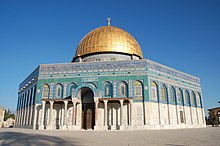
The Siege of Jerusalem (636–637) by the forces of the Rashid Caliph Umar against the Byzantines began in November 636. For four months, the siege continued. Ultimately, the Greek Orthodox Patriarch of Jerusalem, Sophronius, an ethnic Arab,[36] agreed to surrender Jerusalem to Umar in person. The caliph, then in Medina, agreed to these terms and travelled to Jerusalem to sign the capitulation in the spring of 637.
Sophronius also negotiated a pact with Umar known as Umar's Assurance, allowing for the religious freedom for Christians in exchange for jizya, a tax to be paid by conquered non-Muslims, called dhimmis. Under Muslim rule, the Jewish and Christian population of Jerusalem in this period enjoyed the usual tolerance given to non-Muslim theists.[37][38]
Having accepted the surrender, Omar then entered Jerusalem with Sophronius "and courteously discoursed with the patriarch concerning its religious antiquities".[39] When the hour for his prayer came, Omar was in the Anastasis church, but refused to pray there, lest in the future Muslims should use that as an excuse to break the treaty and confiscate the church. The Mosque of Umar, opposite the doors of the Church of the Holy Sepulchre, with the tall minaret, is known as the place to which he retired for his prayer.
Bishop Arculf, whose account of his pilgrimage to the Holy Land in the seventh century, De locis sanctis, written down by the monk Adamnan, described reasonably pleasant living conditions of Christians in Palestine in the first period of Muslim rule. The caliphs of Damascus (661-750) were tolerant princes who were on generally good terms with their Christian subjects. Many Christians, such as John of Damascus, held important offices at their court. The Abbasid caliphs at Baghdad (753-1242), as long as they ruled Syria, were also tolerant to Christians. Harun Abu Jaʻfar (786-809), sent the keys of the Church of the Holy Sepulchre to Charlemagne, who built a hospice for Latin pilgrims near the shrine.[37]
Rival dynasties and revolutions led to the eventual disunion of the Muslim world. In the ninth century, Palestine was conquered by the Fatimid Caliphate, whose capital was Cairo. Palestine once again became a battleground as the various enemies of the Fatimids counterattacked. At the same time, the Byzantines continued to attempt to regain their lost territories, including Jerusalem. Christians in Jerusalem who sided with the Byzantines were put to death for high treason by the ruling Shiʻi Muslims. In 969, the Patriarch of Jerusalem, John VII, was put to death for treasonous correspondence with the Byzantines.
As Jerusalem grew in importance to Muslims and pilgrimages increased, tolerance for other religions declined. Christians were persecuted and churches destroyed. The Sixth Fatimid caliph, al-Hakim bi-Amr Allah, 996–1021, who was believed to be "God made manifest" by his most zealous Shiʻi followers, now known as the Druze, destroyed the Holy Sepulchre in 1009. This powerful provocation helped ignite the flame of fury that led to the First Crusade.[37] The dynasty was later overtaken by Saladin of the Ayyubid dynasty.
Africa
North Africa
In Egypt conversion to Islam was initially considerably slower than in other areas such as Mesopotamia or Khurasan, with Muslims not thought to have become the majority until around the fourteenth century.[41] In the initial invasion, the victorious Muslims granted religious freedom to the Christian community in
Byzantine rule was ended by the Arabs, who invaded
No previous conqueror had tried to assimilate the Berbers, but the Arabs quickly converted them and enlisted their aid in further conquests. Without their help, for example, Andalusia could never have been incorporated into the Islamic state. At first only Berbers nearer the coast were involved, but by the 11th century Muslim affiliation had begun to spread far into the Sahara and Sahel.[46]
The conventional historical view is that the conquest of North Africa by the Islamic Umayyad Caliphate between CE 647–709 effectively ended Catholicism in Africa for several centuries.[47] However, new scholarship has appeared that provides more nuance and details of the conversion of the Christian inhabitants to Islam. A Christian community is recorded in 1114 in Qal'a in central Algeria. There is also evidence of religious pilgrimages after 850 CE to tombs of Catholic saints outside of the city of Carthage, and evidence of religious contacts with Christians of Arab Spain. In addition, calendar reforms adopted in Europe at this time were disseminated amongst the indigenous Christians of Tunis, which would have not been possible had there been an absence of contact with Rome.
During the reign of
Horn of Africa

The history of commercial and intellectual contact between the inhabitants of the
East Africa

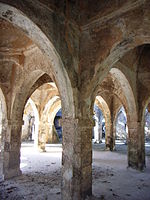
On the east coast of Africa, where Arab mariners had for many years journeyed to trade, mainly in slaves, Arabs founded permanent colonies on the offshore islands, especially on Zanzibar, in the 9th and 10th century. From there Arab trade routes into the interior of Africa helped the slow acceptance of Islam.
By the 10th century, the
(the only one of its kind in the world).In the 20th century, Islam grew in Africa both by birth and by conversion. The number of Muslims in Africa grew from 34.5 million in 1900 to 315 million in 2000, going from roughly 20% to 40% of the total population of Africa.[50] However, in the same time period, the number of Christians also grew in Africa, from 8.7 million in 1900 to 346 million in 2000, surpassing both the total population as well as the growth rate of Islam on the continent.[50][51]
Western Africa
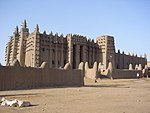
The spread of Islam in Africa began in the 7th to 9th century, brought to North Africa initially under the
Persia and the Caucasus
It used to be argued that

While there were cases such as the Sassanid army division at Hamra, that converted en masse before pivotal battles such as the
Through the
Islam was readily accepted by Zoroastrians who were employed in industrial and artisan positions because, according to Zoroastrian dogma, such occupations that involved defiling fire made them impure.
Robert Hoyland argues that the missionary efforts of the relatively small number of Arab conquerors in Persian lands led to "much interaction and assimilation" between rulers and ruled, and to descendants of the conquerors adapting the Persian language and Persian festivals and culture,[56] (Persian being the language of modern-day Iran, while Arabic is spoken by its neighbors to the west.)
Central Asia

A number of the inhabitants of
Turkey
Main articles:
Indian subcontinent

Islamic influence first came to be felt in the
In
H. G. Rawlinson, in his book Ancient and Medieval History of India (
The Arab merchants and traders became the carriers of the new religion and they propagated it wherever they went.
Embedded within these lies the concept of Islam as a foreign imposition and
- Conversion was a combination, initially by violence, threat or other pressure against the person.[64]
- As a socio-cultural process of diffusion and integration over an extended period of time into the sphere of the dominant Muslim civilization and global polity at large.[65]
- A related view is that conversions occurred for non-religious reasons of pragmatism and patronage such as social mobility among the Muslim ruling elite or for relief from taxes[64][65]
- Was a combination, initially made under duress followed by a genuine change of heart[64]
- That the bulk of Muslims are descendants of migrants from the Iranian plateau or Arabs.[65]
Muslim missionaries played a key role in the spread of Islam in India with some missionaries even assuming roles as merchants or traders. For example, in the 9th century, the
The
Southeast Asia
Even before Islam was established amongst Indonesian communities, Muslim sailors and traders had often visited the shores of modern Indonesia, most of these early sailors and merchants arrived from the

Islam came to the
When
In 1380, Sufi orders carried Islam from here on to
Another driving force for the change of the ruling class in the region was the concept among the increasing Muslim communities of the region when ruling dynasties to attempt to forge such ties of kinship by marriage.[
Flags of the Sultanates in the East Indies
-
Sultanate of Banten
-
Cirebon Sultanate
-
Sultanate of Mataram
-
Sulu
-
Deli
Inner Asia and Eastern Europe

In the mid 7th century AD, following the
Another contemporary institution identified as Muslim, the
Some of the Mongolian tribes became Islamized. Following the brutal
In the 1330s, the Mongol ruler of the
Muslims of Central Asian origin played a major role in the
Europe
There are accounts of the
According to the historian
Hispania / Al-Andalus
The history of Arab and Islamic rule in the Iberian peninsula is probably one of the most studied periods of European history. For centuries after the Arab conquest, European accounts of Arab rule in Iberia were negative. European points of view started changing with the
The tide of Arab expansion after 630 rolled through North Africa up to Ceuta in present-day Morocco. Their arrival coincided with a period of political weakness in the three-centuries-old kingdom established in the Iberian peninsula by the Germanic Visigoths, who had taken over the region after seven centuries of Roman rule. Seizing the opportunity, an Arab-led (but mostly Berber) army invaded in 711, and by 720 had conquered the southern and central regions of the peninsula. The Arab expansion pushed over the mountains into southern France, and for a short period Arabs controlled the old Visigothic province of Septimania (centered on present-day Narbonne). The Arab Caliphate was pushed back by Charles Martel (Frankish Mayor of the Palace) at Poitiers, and Christian armies started pushing southwards over the mountains, until Charlemagne established in 801 the Spanish March (which stretched from Barcelona to present day Navarre).
A major development in the history of Muslim Spain was the dynastic change in 750 in the Arab Caliphate, when an Umayyad Prince escaped the slaughter of his family in Damascus, fled to Cordoba in Spain, and created a new Islamic state in the area. This was the start of a distinctly Spanish Muslim society, where large Christian and Jewish populations coexisted with an increasing percentage of Muslims. There are many stories of descendants of Visigothic chieftains and Roman counts whose families converted to Islam during this period. The at-first small Muslim elite continued to grow with converts, and with a few exceptions, rulers in Islamic Spain allowed Christians and Jews the right specified in the Koran to practice their own religions, though non-Muslims suffered from political and taxation inequities. The net result was, in those areas of Spain where Muslim rule lasted the longest, the creation of a society that was mostly Arabic-speaking because of the assimilation of native inhabitants, a process in some ways similar to the assimilation many years later of millions of immigrants to the United States into English-speaking culture. As the descendants of Visigoths and Hispano-Romans concentrated in the north of the peninsula, in the kingdoms of Asturias/Leon, Navarre and Aragon and started a long campaign known as the 'Reconquista' which started with the victory of the Christian armies in
The Islamic state centered in Cordoba had ended up splintering into many smaller kingdoms (the so-called taifas). While Muslim Spain was fragmenting, the Christian kingdoms grew larger and stronger, and the balance of power shifted against the 'Taifa' kingdoms. The last Muslim kingdom of Granada in the south was finally taken in 1492 by Queen Isabelle of Castille and Ferdinand of Aragon. In 1499, the remaining Muslim inhabitants were ordered to convert or leave (at the same time the Jews were expelled). Poorer Muslims (
Balkans
In Balkan history, historical writing on the topic of conversion to Islam was, and still is, a highly charged political issue. It is intrinsically linked to the issues of formation of national identities and rival territorial claims of the Balkan states. The generally accepted nationalist discourse of the current Balkan historiography defines all forms of Islamization as results of the Ottoman government's centrally organized policy of conversion or dawah. The truth is that Islamization in each Balkan country took place in the course of many centuries, and its nature and phase was determined not by the Ottoman government but by the specific conditions of each locality. Ottoman conquests were initially military and economic enterprises, and religious conversions were not their primary objective. True, the statements surrounding victories all celebrated the incorporation of territory into Muslim domains, but the actual Ottoman focus was on taxation and making the realms productive, and a religious campaign would have disrupted that economic objective.
Ottoman Islamic standards of toleration allowed for autonomous "nations" (millets) in the Empire, under their own personal law and under the rule of their own religious leaders. As a result, vast areas of the Balkans remained mostly Christian during the period of Ottoman domination. In fact, the Eastern Orthodox Churches had a higher position in the Ottoman Empire, mainly because the Patriarch resided in Istanbul and was an officer of the Ottoman Empire. In contrast, Roman Catholics, while tolerated, were suspected of loyalty to a foreign power (the Papacy). It is no surprise that the Roman Catholic areas of Bosnia, Kosovo and northern Albania, ended up with more substantial conversions to Islam. The defeat of the Ottomans in 1699 by the Austrians resulted in their loss of Hungary and present-day Croatia. The remaining Muslim converts in both elected to leave "lands of unbelief" and moved to territory still under the Ottomans. Around this point in time, new European ideas of romantic nationalism started to seep into the Empire, and provided the intellectual foundation for new nationalistic ideologies and the reinforcement of the self-image of many Christian groups as subjugated peoples.
As a rule, the
Immigration
Since the 1960s, many Muslims have migrated to Western Europe. They have come as immigrants,
A
See also
References
Notes
- ^ Also spelled Islamisation; see spelling differences.
Citations
- LCCN 2017942543.
- ISSN 0169-9423.
- ISSN 1875-9823.
- ^ OCLC 34190629.
- ISBN 978-1-78471-073-6– via Google Books.
- ^ Gibbon, ci, ed. Bury, London, 1898, V, 436
- ^ a b c d e f Berkey, pg. 101-102
- ISBN 978-1-107-10612-3.
- ^ "Executive Summary". The Future of the Global Muslim Population. Pew Research Center. 27 January 2011. Retrieved 22 December 2011.
- ^ "Table: Muslim Population by Country | Pew Research Center's Religion & Public Life Project". Features.pewforum.org. 27 January 2011. Retrieved 23 July 2014.
- ISBN 978-0-521-67873-5.
- ^ "Religion and Public Life". Pew Research Center. 2 April 2015. Retrieved 16 April 2016.
- ^ "The Changing Global Religious Landscape". Pew Research Center's Religion & Public Life Project. 5 April 2017. Retrieved 15 February 2018.
- ^ "Main Factors Driving Population Growth". Pew Research Center's Religion & Public Life Project. 2 April 2015. Retrieved 23 October 2018.
- ^ Burke, Daniel (4 April 2015). "The world's fastest-growing religion is ..." CNN. Retrieved 18 April 2015.
- ^ Lippman, Thomas W. (7 April 2008). "No God But God". U.S. News & World Report. Retrieved 24 September 2013.
Islam is the youngest, the fastest growing, and in many ways the least complicated of the world's great monotheistic faiths. It is based on its own holy book, but it is also a direct descendant of Judaism and Christianity, incorporating some of the teachings of those religions—modifying some and rejecting others.
- ^ "Islamicization". The Free Dictionary.
- ISBN 978-0-521-82627-3, retrieved 13 November 2022
- ^ Kennedy, Charles (1996). "Introduction". Islamization of Laws and Economy, Case Studies on Pakistan. Anis Ahmad, Author of introduction. Institute of Policy Studies, The Islamic Foundation. p. 19.
- ^ Lindley-Highfield, M. (2008) '"Muslimization", Mission and Modernity in Morelos: the problem of a combined hotel and prayer hall for the Muslims of Mexico'. Tourism Culture & Communication, vol. 8, no. 2, 85–96.
- ^ Marcia Hermansen (2014). "Conversion to Islam in Theological and Historical Perspectives". In Lewis R. Rambo and Charles E. Farhadian (ed.). The Oxford Handbook of Religious Conversion. Oxford University Press. p. 632.
The process of "Islamization" was a complex and creative fusion of Islamic practices and doctrines with local customs that were considered to be sound from the perspective of developing Islamic jurisprudence. As historian Richard Bulliet has demonstrated based on the evidence of early biographical compendia, in most cases this process took centuries, so that the stereotype of Islam being initially spread by the "sword" and by forced conversions is a false representation of this complex phenomenon
- ^ a b c d Goddard, pg.126-131
- ^ Hourani, pg.22-24
- ^ a b c d e f Lapidus, 200-201
- ^ a b c Hoyland, In God's Path, 2015: p. 207
- ^ a b c Hourani, pg.41-48
- ^ a b Lapidus, 271.
- ^ Hourani, pg.54
- ^ a b c Fred Astren pg.33-35
- ^ a b c Tobin 113-115
- ^ Hoyland, In God's Path, 2015: p. 229
- ^ Hourani, pg.221,222
- ISBN 978-0-313-37957-4. Retrieved 8 June 2013.
- ^ Lapidus, p. 823
- ^ a b c Lapidus, p. 828–30
- ^ Donald E. Wagner. Dying in the Land of Promise: Palestine and Palestinian Christianity from Pentecost to 2000
- ^ a b c "Jerusalem". Catholic Encyclopedia. 1910.
- ISBN 978-0-87820-217-1.
- ^ Gibbon, ci, ed. Bury, London, 1898, V, 436
- ^ ISBN 978-0-262-08136-8. Retrieved 15 February 2015.
- ^ Hoyland, In God's Path, 2015: p. 161
- Britannica. 2007.
- ^ Hoyland, In God's Path, 2015: p. 97
- ISBN 978-0-521-33767-0. Retrieved 15 February 2015.
- ISBN 978-1-57607-004-8. Retrieved 15 February 2015.
- Britannica. 2007.
- ^ "Western North African Christianity: A History of the Christian Church in Western North Africa". Archived from the original on 2 February 2007. Retrieved 22 July 2010.
- ^ a b c d e f The preaching of Islam: a history of the propagation of the Muslim faith By Sir Thomas Walker Arnold, pp.125-258
- ^ "A Country Study: Somalia from The Library of Congress". Retrieved 15 February 2015.
- ^ a b "The Return of Religion: Currents of Resurgence, Convergence, and Divergence- The Cresset (Trinity 2009)". Retrieved 22 June 2011.
- ^ "Christian Number-Crunching reveals impressive growth". Retrieved 22 June 2011.
- ^ "Paul Stoller, "Money Has No Smell: The Africanization of New York City," Chicago: University of Chicago Press". Archived from the original on 23 December 2007.
- ^ Raza, Mohammad (21 May 2023). "Who wrote book Theologus Autodidactus ?| How was the Islamic golden age | How Islam spread ? |". Think With Wajahat. Retrieved 21 May 2023.
- ^ Shireen Hunter; Jeffrey L. Thomas; Alexander Melikishvili; et al. (2004). Islam in Russia: The Politics of Identity and Security. M.E. Sharpe. p. 3.
(..) It is difficult to establish exactly when Islam first appeared in Russia because the lands that Islam penetrated early in its expansion were not part of Russia at the time, but were later incorporated into the expanding Russian Empire. Islam reached the Caucasus region in the middle of the seventh century as part of the Arab conquest of the Iranian Sassanian Empire.
- ISBN 978-0-203-64167-5. Retrieved 17 December 2014.
- ^ Hoyland, In God's Path, 2015: p. 206
- ^ The preaching of Islam: a history of the propagation of the Muslim faith, By Thomas Walker Arnold, p. 183
- ^ The History of Iran By Elton L. Daniel, pg. 74
- ^ "New Age | the Outspoken Daily". Archived from the original on 25 December 2013. Retrieved 24 December 2013.
- ISBN 978-1-317-58745-3.
- ^ Sturrock, J., South Canara and Madras District Manual (2 vols., Madras, 1894–1895)
- ISBN 978-81-85843-05-6Cultural Heritage of India Vol. IV
- ^ "Mujeeb Jaihoon". jaihoon.com. Archived from the original on 22 June 2006.
- ^ a b c d e der Veer, pg 27–29
- ^ a b c Eaton, "5. Mass Conversion to Islam: Theories and Protagonists"
- ISBN 978-0-521-29137-8.
- ^ The preaching of Islam: a history of the propagation of the Muslim faith By Sir Thomas Walker Arnold, p. 212
- ^ The preaching of Islam: a history of the propagation of the Muslim faith By Sir Thomas Walker Arnold, pp. 227–228
- ISBN 978-1-136-95036-0.
- ISBN 978-1-78347-572-8.
- ^ "An Outline of the History of Persia During the Last Two Centuries (A.D. 1722–1922)". Edward G. Browne. London: Packard Humanities Institute. p. 33. Retrieved 24 September 2010.
- ^ Ian Copland; Ian Mabbett; Asim Roy; et al. (2012). A History of State and Religion in India. Routledge. p. 161.
- ^ Sinbad the Sailor
- ^ ISBN 978-0-521-29137-8pg.123-125
- ^ ISBN 978-1-86508-838-9pg.31-33
- ^ He changes his name to reflect his new religion.
- ^ Shireen Hunter; Jeffrey L. Thomas; Alexander Melikishvili; et al. (2004). Islam in Russia: The Politics of Identity and Security. M.E. Sharpe. p. 3.
(..) It is difficult to establish exactly when Islam first appeared in Russia because the lands that Islam penetrated early in its expansion were not part of Russia at the time, but were later incorporated into the expanding Russian Empire. Islam reached the Caucasus region in the middle of the seventh century as part of the Arab conquest of the Iranian Sassanian Empire.
- ^ Arnold, Sir Thomas Walker (1896). The Preaching of Islam. Retrieved 15 February 2015.
- ^ a b c d e f Devin pg. 19
- ^ Devin pg 67-69
- ^ ISBN 978-0-631-21604-9pg. 185-187
- ^ Devin 160.
- ^ ISBN 978-0-7656-1317-2pg. 46-48
- ^ "PontosWorld". pontosworld.com.
- ^ ISBN 978-0-230-11908-6.
- ^ "Nothing found for The Future Of The Global Muslim Population Aspx?print=true". Archived from the original on 23 March 2012.
Sources
- Astren, Fred. Karaite Judaism and Historical Understanding, Univ of South Carolina Press, 2004 (ISBN 978-1-57003-518-0).
- Berkey, Jonathan. The Formation of Islam, ISBN 978-0-521-58813-3).
- Devin De Weese, Devin A, Islamization and Native Religion in the Golden Horde, ISBN 978-0-271-01073-1).
- Eaton, Richard M. The Rise of Islam and the Bengal Frontier, 1204-1760. Berkeley: University of California Press, c1993 1993.Online version last accessed on 1 May 1948
- Goddard, Hugh Goddard, Christians and Muslims: from double standards to mutual understanding, Routledge (UK), 1995 (ISBN 978-0-7007-0364-7).
- Hourani, Albert, 2002, A History of the Arab Peoples, Faber & Faber (ISBN 978-0-571-21591-1).
- Kayadibi, Saim. Ottoman Connections to the Malay World: Islam, Law and Society, Kuala Lumpur: The Other Press, 2011 (ISBN 978-983-9541-77-9).
- Lapidus, Ira M. 2002, A History of Islamic Societies. Cambridge: Cambridge University Press.
- Savage, Timothy M. "Europe and Islam: Crescent Waxing, Cultures Clashing" Archived 27 September 2007 at the Wayback Machine, The Washington Quarterly, Summer 2004.
- Schuon, Frithjof, Understanding Islam, World Wisdom Books, 2013.
- Siebers, Tobin. "Religion and the Authority of the Past", University of Michigan Press, 1993 (ISBN 978-0-472-08259-9).
- Soares de Azevedo, Mateus. Men of a Single Book: Fundamentalism in Islam and Christianity, World Wisdom, 2011.
- Stoddart, William, What does Islam mean in today's world?, World Wisdom Books, 2011.
- Stoller, Paul. Money Has No Smell: The Africanization of New York City, (University of Chicago Press, 2001) (ISBN 978-0-226-77529-6).
- van der Veer, Peter. Religious Nationalism: Hindus and Muslims in India, University of California Press, 1994 (ISBN 978-0-520-08256-4).
- Hoyland, Robert G. (2015). In God's Path: the Arab Conquests and the Creation of an Islamic Empire. Oxford University Press.






